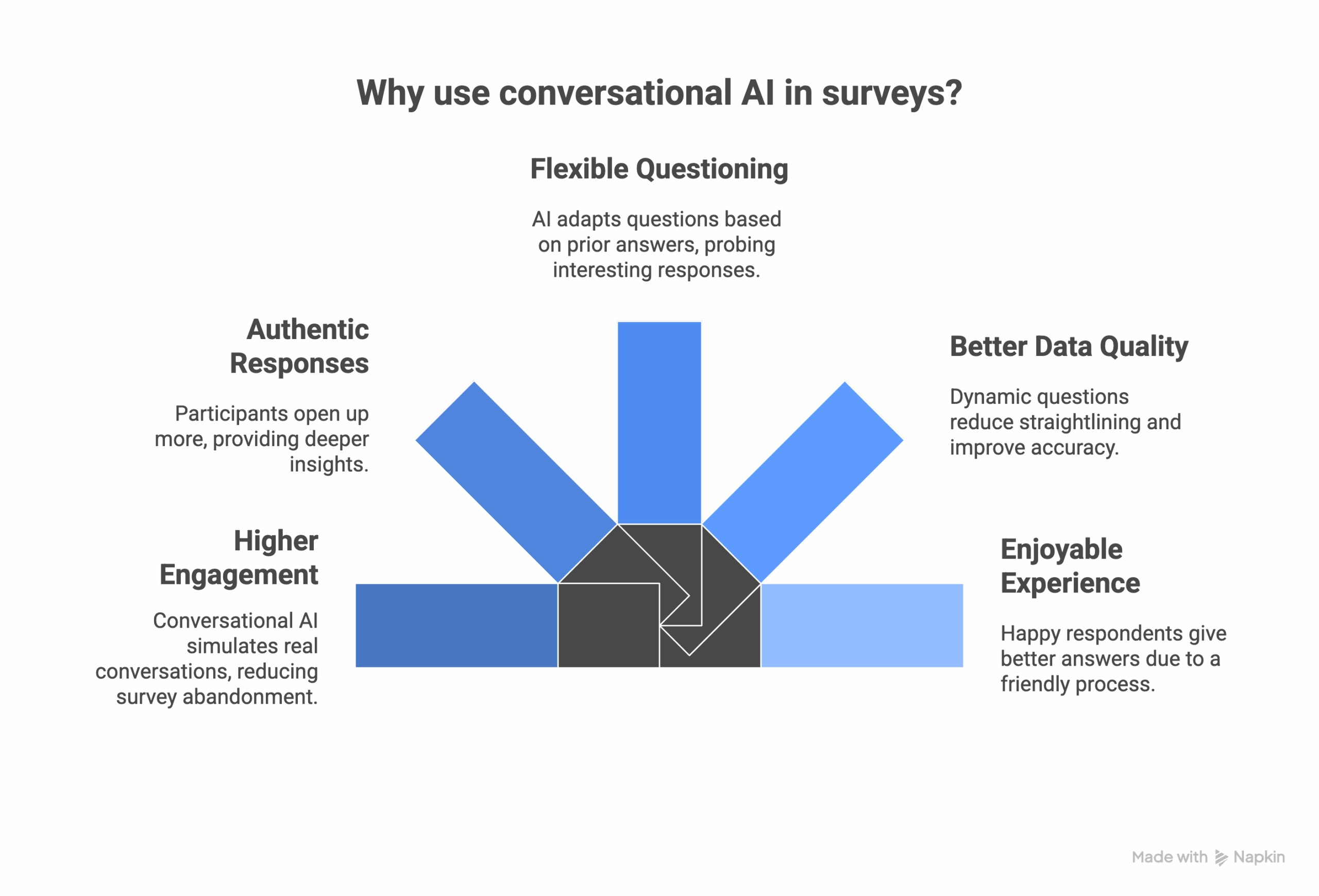Surveys are a foundational tool in market research, offering the scale and structure needed to gather meaningful feedback from a wide audience. Now, thanks to advances in conversational AI, we can take that trusted approach even further.
By adding a conversational layer using AI, surveys become more interactive and engaging, allowing respondents to share their thoughts more naturally and in their own words. This hybrid approach combines the rigor of structured questions with the flexibility of real-time, human-like follow-ups, helping us uncover deeper insights and deliver richer stories behind the data.
What We Mean By Conversational AI In Surveys
Conversational AI in surveys uses artificial intelligence to simulate a natural, human-like dialogue with respondents. Instead of working through a static list of questions, participants interact with an AI “moderator” that asks questions, reacts to answers, and adjusts follow-ups in real time.
How It Works
At its foundation, this is still a survey. We start with the same disciplined pre-work we’d do for any study: identifying your learning objectives, defining key metrics, and crafting the right set of questions to get the answers you need. This means we can still include structured survey-style items like scaled ratings, rankings, or multiple-choice questions to capture consistent, comparable data.
The conversational AI layer is an addition to all of this. Once the core survey is built, we add into AI-supported open-ended question follow-ups to adapt based on prior survey answers. For example, if someone rates a product feature as “low,” the AI might naturally ask, “What would make this feature more useful for you?” This lets us keep the rigor of a traditional survey while adding the depth and flexibility of interview-style exchanges.
The User Experience
From the participant’s perspective, a conversational AI survey feels more like chatting with a friendly interviewer than filling out a form. Instead of scrolling through a long page of questions, they see one question at a time, often accompanied by a short, natural-sounding prompt or follow-up.
Respondents type their answers in a chat-style interface, just as they would in a messaging app. When they choose from predefined options, the AI can still acknowledge their choice in a conversational way (e.g., “Got it—you prefer Option B. Can you tell me what makes that your top choice?”). This keeps the experience fluid, personal, and engaging.
Because the interface blends structured questions with adaptive follow-ups, participants don’t feel like they’re repeating themselves or being rushed through irrelevant sections. The conversation adapts to their inputs, making it both faster and more enjoyable, while still delivering the rigor we need for analysis.
What Happens After We Collect Respondent Feedback
Once data collection wraps, we analyze the responses much like we would any other qualitative or quantitative data set.
Surveys with conversational AI capture two types of data during the experience:
- Structured responses from scaled ratings, rankings, and multiple-choice questions.
- Open-ended responses from the AI-driven follow-ups and free-text answers.
We analyze the structured data just as we would in any traditional survey, running statistical analysis, segmenting results, and identifying trends across different respondent groups.
The open-ended data gets a hybrid treatment: we start with AI-powered text analysis to quickly surface themes, sentiments, and keywords, and then our research team steps in to validate, interpret, and pull out the most meaningful patterns. This combination keeps the process efficient while ensuring human judgment guides the final insights.
The result? A complete picture. Hard numbers that show what’s happening, paired with rich qualitative detail that helps explain why.
What Has Us Excited About Conversational AI In Surveys
In traditional surveys, participants often face rigid, multiple-choice questions that can feel impersonal or worse, tedious. Conversational AI changes that dynamic by creating a more natural, human-like exchange that keeps people engaged and willing to share more thoughtful feedback. Here’s are just a few reasons why we’re excited about it.

1. Higher Engagement, Lower Drop-Off
Conversational AI simulates the feel of a real conversation, making the survey experience more inviting and less like “taking a test.” This keeps respondents engaged longer and reduces mid-survey abandonment.
2. Richer, More Authentic Responses
When questions feel like they come from a person rather than a form, participants often open up more. This leads to deeper insights, especially for open-ended questions or topics that benefit from nuanced feedback.
3. Greater Flexibility in Questioning
Instead of forcing respondents down a fixed path, conversational AI adapts follow-up questions based on prior answers. That means we can probe interesting responses in real time, just like a skilled interviewer would.
4. Better Data Quality
By keeping participants engaged via dynamic questions, conversational AI can reduce “straightlining” (giving the same answer over and over) and improve response accuracy.
5. A More Enjoyable Experience for Respondents
Happy respondents give better answers. When the process feels friendly, fluid, and even a little fun, people are more likely to put genuine thought into their responses, benefiting both them and the research outcomes.
When Conversational AI Isn’t The Right Fit
While conversational AI is a powerful tool in the research toolkit, it’s not a silver bullet. And, it is certainly not a substitute for thorough qualitative method, especially in-depth interviews. Here are a few reasons why.
1. Limited Ability to Read Between the Lines
Human interviewers pick up on pauses, tone shifts, or facial expressions that signal something important. These are subtleties a text-based AI can’t fully capture. This means some emotional cues or unspoken context may be missed.
2. No True Back-and-Forth Nuance
Even with smart follow-ups, conversational AI operates within predefined rules and logic. It can’t improvise in the same way an experienced interviewer can when a conversation takes an unexpected turn.
3. Dependent on Respondent Comfort with Text
Not everyone feels equally comfortable expressing themselves in written form. For certain audiences, or topics, voice-based or face-to-face conversations may yield richer detail.
4. Context Gaps Can Still Happen
Because conversational AI isn’t “listening” to the world around the respondent, it can occasionally misinterpret ambiguous answers or miss chances to clarify, something a live interviewer would naturally do.
5. Best for Breadth, Not Depth
Conversational AI can efficiently capture broad themes and initial impressions from many people at once. But when you need to deeply explore complex motivations or unpack highly nuanced topics, a skilled human interviewer remains unmatched.
Market Research Projects Best Positioned For Conversational AI
Like any research method, conversational AI shines brightest when it’s matched to the right objectives. Based on its strengths, and its limitations, here are some project types where it really shines:
- Message and Creative Testing: When you want to understand why a message, headline, or ad concept resonates (or doesn’t), conversational AI can quickly follow up with probing questions that uncover the reasoning behind a rating or choice.
- Early-Stage Product or Service Feedback: If you’re exploring a new product idea or feature, this approach helps gather broad reactions while also uncovering the nuances. This includes capturing what people love, what’s unclear, and where expectations don’t align.
- Brand Perception Tracking with Depth: Traditional brand trackers deliver metrics, but conversational AI can capture the human language behind them, helping explain shifts in awareness, favorability, or consideration over time.
- Customer Journey Insights: For studies mapping how people discover, evaluate, and purchase, conversational AI can prompt respondents to share stories or specific examples that illuminate the journey beyond the numbers.
- Market Landscape Exploration: When you’re looking for a wide range of perspectives on a new category, industry trend, or unmet need, conversational AI allows you to gather both breadth and depth without the time and cost of dozens of one-on-one interviews.
Of course, this naturally means there are situations where you should not use conversational AI. Projects that require deep emotional probing, exploration of highly sensitive topics, or complex multi-layered discussions are often better suited for in-depth interviews or focus groups.
That’s because skilled moderators can read subtle cues, adapt their questions in the moment, and build the kind of trust that encourages people to open up. They pivot when a conversation takes an unexpected turn and gently dig deeper when someone hesitates. When these human touches are crucial, more traditional qualitative methods are the right choice.






